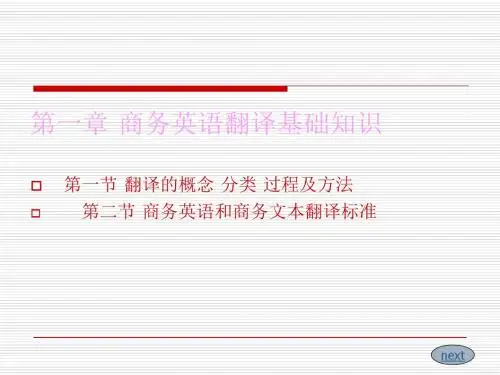商务英语翻译培训讲义
- 格式:ppt
- 大小:134.00 KB
- 文档页数:85

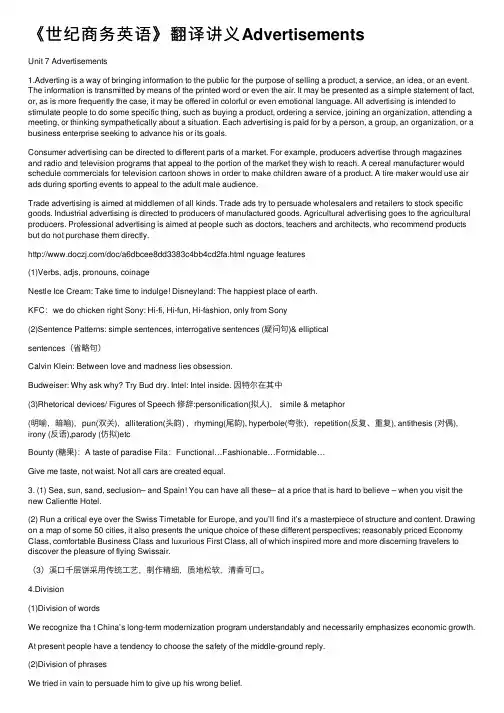
《世纪商务英语》翻译讲义AdvertisementsUnit 7 Advertisements1.Adverting is a way of bringing information to the public for the purpose of selling a product, a service, an idea, or an event. The information is transmitted by means of the printed word or even the air. It may be presented as a simple statement of fact, or, as is more frequently the case, it may be offered in colorful or even emotional language. All advertising is intended to stimulate people to do some specific thing, such as buying a product, ordering a service, joining an organization, attending a meeting, or thinking sympathetically about a situation. Each advertising is paid for by a person, a group, an organization, or a business enterprise seeking to advance his or its goals.Consumer advertising can be directed to different parts of a market. For example, producers advertise through magazines and radio and television programs that appeal to the portion of the market they wish to reach. A cereal manufacturer would schedule commercials for television cartoon shows in order to make children aware of a product. A tire maker would use air ads during sporting events to appeal to the adult male audience.Trade advertising is aimed at middlemen of all kinds. Trade ads try to persuade wholesalers and retailers to stock specific goods. Industrial advertising is directed to producers of manufactured goods. Agricultural advertising goes to the agricultural producers. Professional advertising is aimed at people such as doctors, teachers and architects, who recommend products but do not purchase them directly./doc/a6dbcee8dd3383c4bb4cd2fa.html nguage features(1)Verbs, adjs, pronouns, coinageNestle Ice Cream: Take time to indulge! Disneyland: The happiest place of earth.KFC:we do chicken right Sony: Hi-fi, Hi-fun, Hi-fashion, only from Sony(2)Sentence Patterns: simple sentences, interrogative sentences (疑问句)& ellipticalsentences(省略句)Calvin Klein: Between love and madness lies obsession.Budweiser: Why ask why? Try Bud dry. Intel: Intel inside. 因特尔在其中(3)Rhetorical devices/ Figures of Speech 修辞:personification(拟⼈), simile & metaphor(明喻,暗喻),pun(双关),alliteration(头韵) ,rhyming(尾韵), hyperbole(夸张),repetition(反复、重复), antithesis (对偶), irony (反语),parody (仿拟)etcBounty (糖果):A taste of paradise Fila:Functional…Fashionable…Formidable…Give me taste, not waist. Not all cars are created equal.3. (1) Sea, sun, sand, seclusion– and Spain! You can have all these– at a price that is hard to believe – when you visit the new Calientte Hotel.(2) Run a critical eye over the Swiss Timetable for Europe, and you’ll find it’s a masterpiece of structure and content. Drawing on a map of some 50 cities, it also presents the unique choice of these different perspectives; reasonably priced Economy Class, comfortable Business Class and luxurious First Class, all of which inspired more and more discerning travelers to discover the pleasure of flying Swissair.(3)溪⼝千层饼采⽤传统⼯艺,制作精细,质地松软,清⾹可⼝。

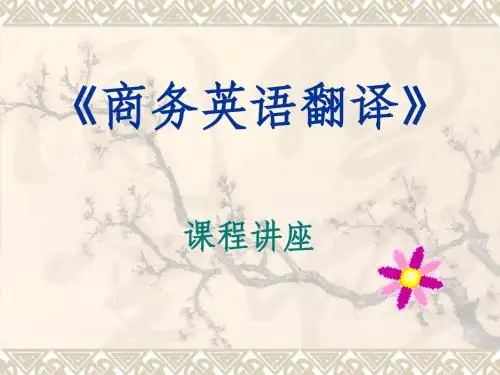
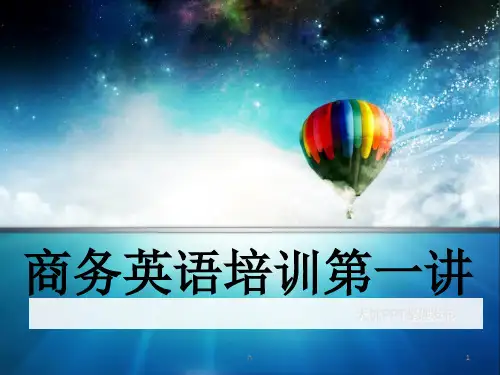
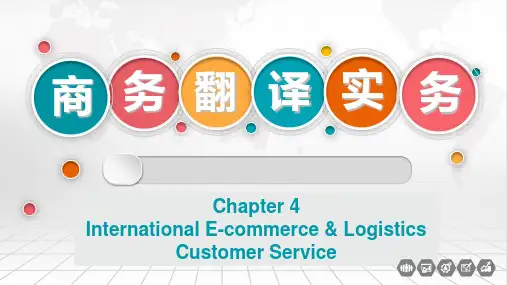
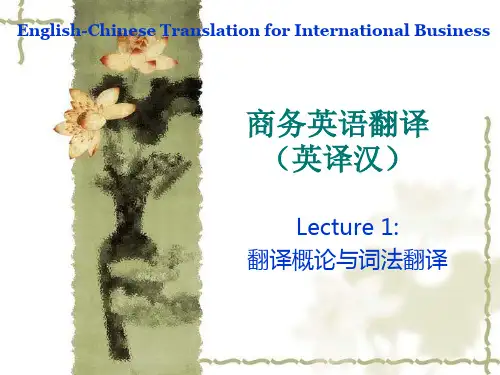
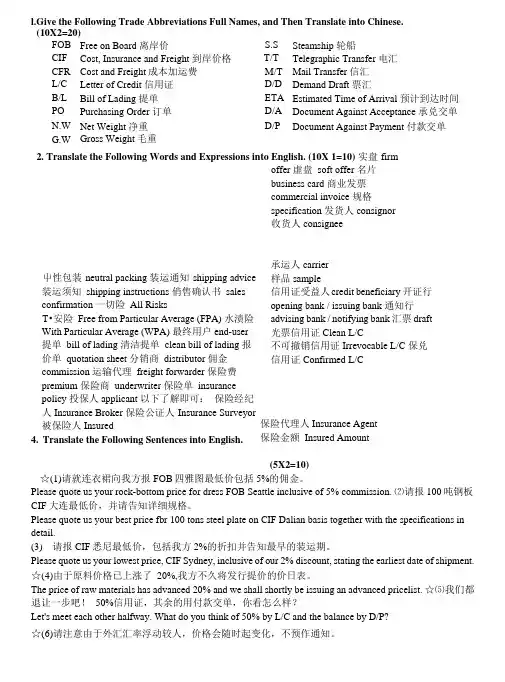
l.Give the Following Trade Abbreviations Full Names, and Then Translate into Chinese.(10X2=20)FOB Free on Board 离岸价 S.S Steamship 轮船CIF Cost, Insurance and Freight 到岸价格 T/T Telegraphic Transfer 电汇CFR Cost and Freight 成本加运费 M/T Mail Transfer 信汇L/C Letter of Credit 信用证 D/D Demand Draft 票汇B/L Bill of Lading 提单 ETA Estimated Time of Arrival 预计到达时间PO Purchasing Order 订单 D/A Document Against Acceptance 承兑交单N.W Net Weight 净重 D/P Document Against Payment 付款交单G.W Gross Weight 毛重屮性包装 neutral packing 装运通知 shipping advice装运须知 shipping instructions 俏售确认书 salesconfirmation 一切险 All RisksT •安险 Free from Particular Average (FPA) 水渍险With Particular Average (WPA) 最终用户end-user提单 bill of lading 清洁提单 clean bill of lading 报价单 quotation sheet 分销商 distributor 佣金commission 运输代理 freight forwarder 保险费premium 保险商 underwriter 保险单 insurancepolicy 投保人applicant 以下了解即可: 保险经纪人Insurance Broker 保险公证人 Insurance Surveyor被保险人Insured4. Translate the Following Sentences into English. Please quote us your rock-bottom price for dress FOB Seattle inclusive of 5% commission. ⑵请报100吨钢板CIF 大连最低价,并请告知详细规格。
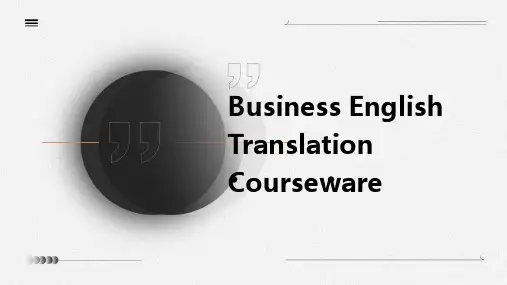
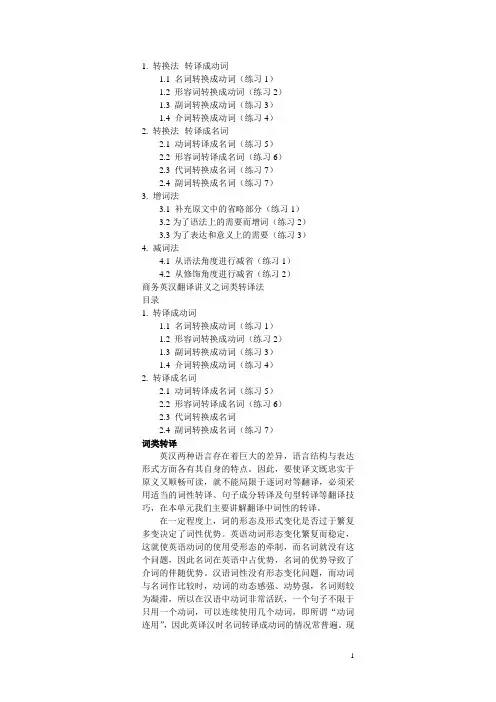
1. 转换法--转译成动词1.1 名词转换成动词(练习1)1.2 形容词转换成动词(练习2)1.3 副词转换成动词(练习3)1.4 介词转换成动词(练习4)2. 转换法--转译成名词2.1 动词转译成名词(练习5)2.2 形容词转译成名词(练习6)2.3 代词转换成名词(练习7)2.4 副词转换成名词(练习7)3. 增词法3.1 补充原文中的省略部分(练习1)3.2为了语法上的需要而增词(练习2)3.3为了表达和意义上的需要(练习3)4. 减词法4.1 从语法角度进行减省(练习1)4.2 从修饰角度进行减省(练习2)商务英汉翻译讲义之词类转译法目录1. 转译成动词1.1 名词转换成动词(练习1)1.2 形容词转换成动词(练习2)1.3 副词转换成动词(练习3)1.4 介词转换成动词(练习4)2. 转译成名词2.1 动词转译成名词(练习5)2.2 形容词转译成名词(练习6)2.3 代词转换成名词2.4 副词转换成名词(练习7)词类转译英汉两种语言存在着巨大的差异,语言结构与表达形式方面各有其自身的特点。
因此,要使译文既忠实于原义又顺畅可读,就不能局限于逐词对等翻译,必须采用适当的词性转译、句子成分转译及句型转译等翻译技巧,在本单元我们主要讲解翻译中词性的转译。
在一定程度上,词的形态及形式变化是否过于繁复多变决定了词性优势。
英语动词形态变化繁复而稳定,这就使英语动词的使用受形态的牵制,而名词就没有这个问题,因此名词在英语中占优势,名词的优势导致了介词的伴随优势。
汉语词性没有形态变化问题,而动词与名词作比较时,动词的动态感强、动势强,名词则较为凝滞,所以在汉语中动词非常活跃,一个句子不限于只用一个动词,可以连续使用几个动词,即所谓“动词连用”,因此英译汉时名词转译成动词的情况常普遍。
现将词性转译按转译成汉语动词、转译成汉语名词、转译成汉语形容词、转译成汉语副词等四种情况分类讲解。
1. 转译成动词英语和汉语比较起来,汉语中动词用得比较多。
